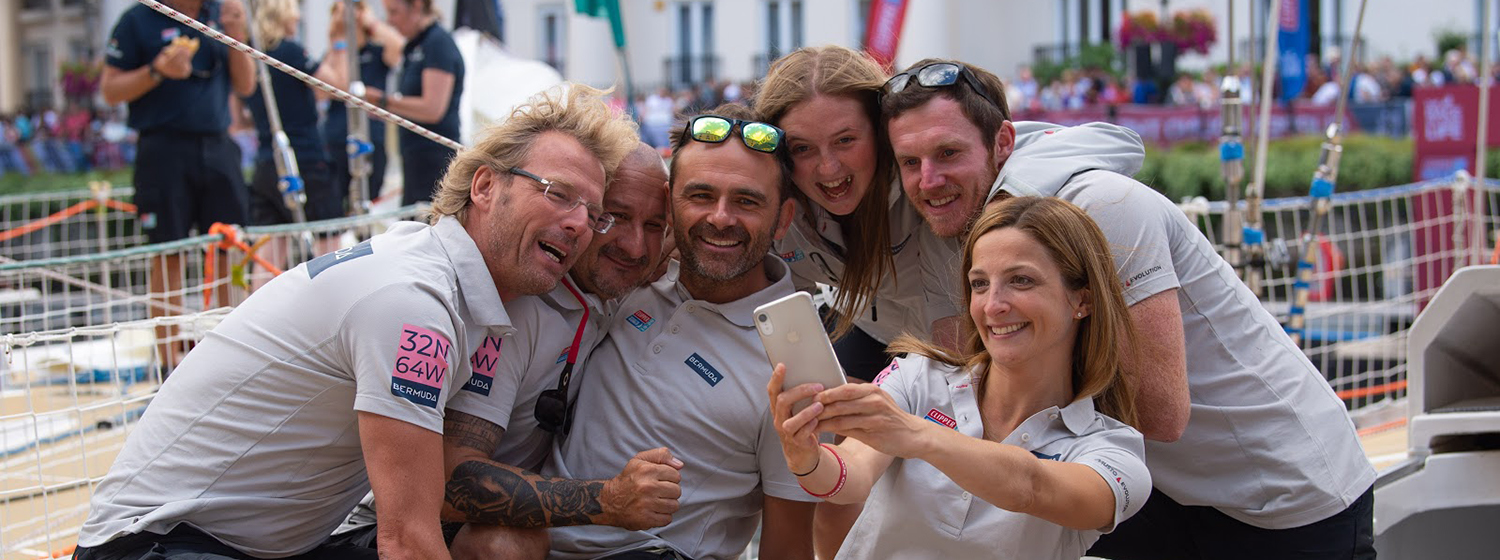Meet the Crew: Lee Callaghan
27 October 2020
A consultant within the renewable energy sector, wind power has always been central to Lee Callaghan’s career. But taking part in the Clipper Race, Lee, who hails from Scotland, experienced its force first hand as he battled the notorious Pampero weather phenomenon off Uruguay. Competing on the GoToBermuda team in the first stage of the Clipper 2019-20 Race, Lee witnessed the fanfare of leaving London, fierce swells in the Bay of Biscay and then a 5000 nautical miles, 30 day, physical and mental slog to South America.
Whilst many Race Crew spend years dreaming of being a sailor, for Lee it was a series of markers in his life that seemed to be giving him a gentle prod in the direction of becoming an ocean racer.
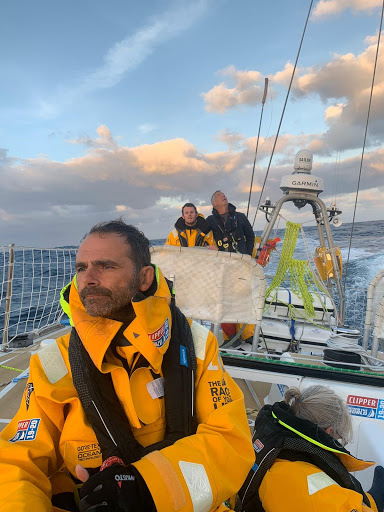
Why did you sign up for this adventure?
Over the years, I’ve had lots of messages from the universe to sign up to the Clipper Race. Sailing had always been an idea in the background of my life, but one that took me many years to make a reality.
I’d been at my company, in the renewable energy industry, for 20 years.Throughout my career I’d been involved in leadership roles and understood the importance of effective teamwork and working safely to achieve high performance but I decided that testing what I’d learned in the corporate environment on a stripped out Clipper 70 in offshore race conditions was a unique opportunity. I’d become aware of the race and straight away there was a real connection.
I had my interview in December 2018 and as part of this we toured a Clipper 70. I remember looking out at the unbranded yachts and thinking, I can’t wait to be on one of these as part of a race team. It was one of those life moments. I decided right then I was going to commit to the race.
For me it had to be Leg 1, as I’d always had a fascination with South America, one of the continents I hadn’t been to. I also wanted to sail from the UK, right at the start of the circumnavigation. I’m on the waiting list for the final stage, Leg 8. It would be perfect to be involved at the start and finish of the global race.
How much sailing had you experienced before the Clipper Race?
This is one of the first questions people asked me when they heard I’d signed up and the answer is not lots!
I grew up in Jeddah, in Saudi Arabia. Our neighbour was Greek and into sailing and he took us out on his boat. Nobody in our family sailed, my Dad only had to look at a boat and he’d feel seasick. But I’d always felt a connection to the sea, the beach and boats. Then another family friend in Saudi, Peter Croxall, had a small speedboat and took us out often. He was another reason I’d loved the sea and boats so much. I hadn’t seen him for around 15 years but I invited him to Race Start in London and it was a really nice connection as that early experience with him had led me to taking part in the race.
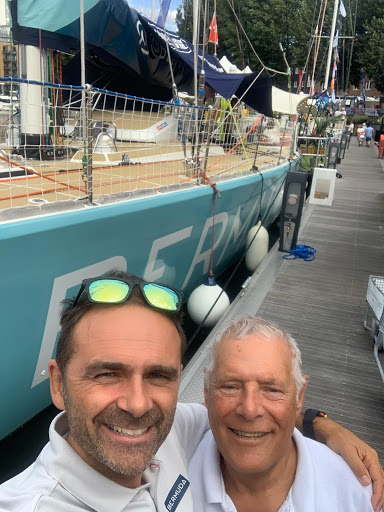
Lee with Peter Croxall in London for Race Start
Also, my dad before he passed away had always said to me “why don’t you go for it and take up sailing. You keep talking about - why haven’t you done it yet?”
In 2008, I completed a RYA Level 2 course, at Port Edgar right under the Forth Bridge, in Scotland. It was only over a few weekends but I loved it. My first experience of proper sailing.
Later that year, before we got married, my wife Laura and I travelled around Australia and went to the Whitsundays. We stopped at Airlie Beach, like most backpackers do. We went out on a small catamaran with only four berths. Every morning I was up early trying to be the skipper’s best friend and learn what I could about sailing. Again, I just loved the sailing we did. And much later on, when looking into the Clipper Race I noticed the race route passed the areas I had been so it felt like another sign.
What was Clipper Race Training like for you?
I’d compressed my training dates so I could squeeze them in between other life commitments and excitingly my Level 1 and Crew Allocation were together in May 2019. There was one day of getting to know each other and the boat, then off we went to Portsmouth’s Guildhall. I loved the way Crew Allocation was organised, with the big reveal of your team. It was like finding out who your teacher was going to be at school.
I’d been speculating about which team I'd be on. I thought maybe I’d be with Seumas (Kellock) because of the Scottish connection, or maybe Jeronimo because of all the work I’d done with Spanish companies. But then I was selected for GoToBermuda and when I looked into the background of Skipper Wavy (David Immelman), I felt that he was someone who had so much sailing experience I knew I could learn a lot from him.
I really enjoy meeting new people and it feels like it’s easy for me to connect with people. We had lots of Chinese ambassadors in our Level 1 training crew, one of which I was buddied up with for galley duty. It was definitely a challenge for both of us, making that first meal (a curry) in such a small space, for 20 people and with a limited cooking kit - but we muddled through somehow.
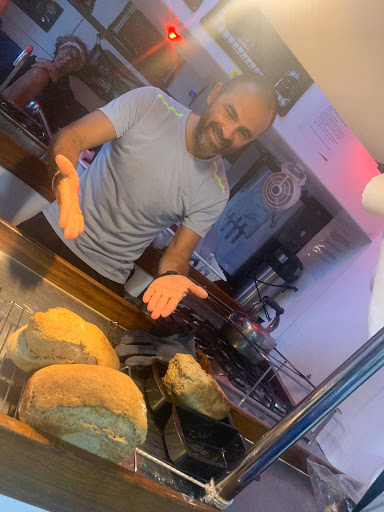
Lee showing off his baking prowess
We had a great Training Skipper in Cliff, who I’m still in touch with. He gave me an insight into how to give solid guidance to a team of novices. I put a lot of pressure on myself during that first week of training. I did what I encourage people to avoid doing in the workplace - assuming you have to know everything immediately and putting too much pressure on yourself to get everything right the first time. I’d had to abandon everything I knew and start again. I wanted to prove to myself that I could go into a new learning environment. I didn’t have 20 years of sailing experience, like I had with my job, but I wanted to be a good crew member, to be skilled enough to be useful and also be supportive to others. I also needed to decide on my own definition of the race and what I wanted to get out of it.
I’d really worked on my ability to move about the training yacht safely and swiftly. But then in the build up to my Level 4 training I was a bit worried about transferring over to the Clipper 70s as everything I’d learnt was based on the Clipper 68.
I wasn’t a Boy Scout so the knots were all new to me. I’d carried rope with me on holiday so I could practice and it was a big achievement when I’d mastered them, even though it was something I had to continually practice!
The conditions weren’t too tough as I was training over the summer months but I felt we all learnt the skills and experience we needed to sail in the race for real and in real conditions.
How did your family feel about you signing up?
My wife was concerned at the start but then she came to London and everything changed. Due to the phenomenal race start she got the bug and turned into an avid Race Crew Supporter. She was forever tuned into the Race Viewer and was tracking GoToBermuda even more than me when I was back home after competing in Leg 1.
I wanted the race to be for all of us, as a family. The kids learnt about where we were going and their school was fully involved with the teacher bringing the race into lessons. And when I returned I went into class to talk about the race and was timed putting my foulies on and had water thrown at me by the kids which was fun. That’s what’s special about the race - the wider reach of it, children can get involved and embrace the race experience themselves.
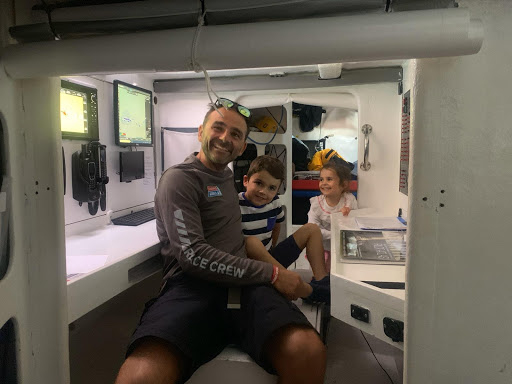
Lee giving his children a tour of GoToBermuda the Clipper 70 he was sailing on board
Also, I loved finding out that my old colleagues had closely followed my team and showed the Race Viewer in team meetings.
How quickly did you get into racing mode after the pomp and fanfare of leaving London?
It was an interesting transition to experience. Leaving London and the celebration of that was bigger than I could have just imagined. There was a feeling you picked up, not just from my own friends and family that came to see me off but also the feeling from the huge numbers of the public who were there too. So that was a great starting point.
Leaving as we did, I still felt really focussed. Although I’d enjoyed the adrenaline of going down the RiverThames, I was already focussing on the next part and Race Start proper. Although the atmosphere on board had been relaxed and positive, it was still positive with a seriousness.
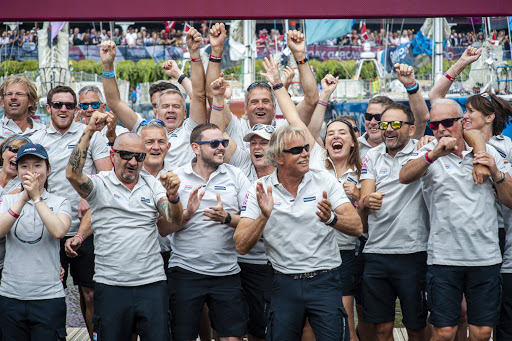
The GoToBermuda team celebrate on stage at Race Start in London
Minds were already turning to what we would be doing the next day. I’ve got a great shot that I took looking back towards the mouth of the Thames and there’s a couple of wind turbines in the background. And working in wind power and with the sun going down, it was quite metaphorical. Looking back at things I had done and then looking the other way, straight out to the open and what lay ahead, it was a nice contrast. I’ve looked back at this photo quite a bit since I’ve been home.
Although we were prepared and focused, there was a little period overnight, where there was a no man’s land of feelings and emotions. We settled down, went to sleep but still had social things on our mind, life at home and then next day, bang, we were straight in.
Here’s what I wrote in the team’s first blog from Race Start
“Although some had only managed limited sleep the previous night, due to a combination of late anchor watch slots and the adrenalin/emotion which had carried over from our sail away and journey down the Thames, there were no signs of tiredness amongst the crew as we gathered for breakfast in the galley - just a calm focus!”
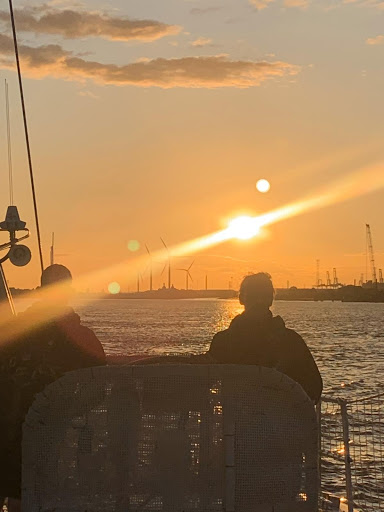
At the mouth of the Thames
Were the conditions of Race 1 a rude awakening?
When I signed up to Leg 1, I had envisioned the race would go straight to South America like it had in the past edition. Then when the stopover in Portimão was introduced, I stupidly thought “I didn’t sign up for a one week holiday in Portugal. I want to do this and get straight on.” That was completely naive and we needed that break and that recharge.
I’d only known summer conditions around the Solent. So whilst I’d seen a bit of weather, I hadn’t experienced that prolonged, sustained, set of conditions that we had on Race 1 and it took a huge amount out of the crew. I think it was really important for us to go through that. It probably helped us as a crew to be stronger through the other side of it. But it was really, really tough as quite a lot of the crew went down and stayed down (with seasickness). But even though I felt sick myself at times and had to go through that process, for me, I was able to manage that in a way where I kept working.
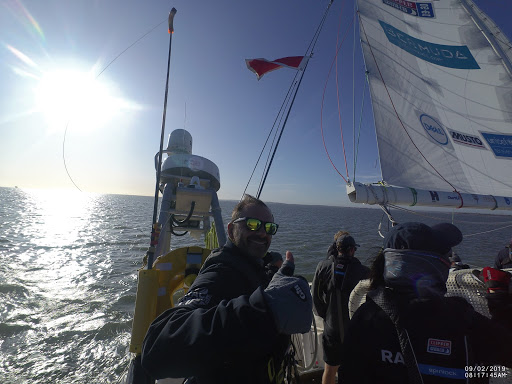
There was a moment on the bow, when I was helping to get a sail down, I had, well to put it politely, I had felt better...but just had to keep going. And having done that, I felt quite good that I just could get through it and power through.
When you are new to sailing, you always question and wonder whether you are cut out for it and whether you can cope with the conditions. Back in training it was reassuring to hear from experienced sailors, like our Skippers, that generally everyone gets seasick at some point or other. It’s more about how you cope with it. I love the Mohammad Ali quote: “ain’t nothing wrong with going down, it’s staying down that’s wrong”. That just kept going round in my mind as I kept getting back up and going again. And then later on in the passage and even on the next race, I really enjoyed some of the rougher conditions.
There are times in the moment when you appreciated everything that was going on and the intensity of it, and that gave me a feeling that I hadn’t previously felt or known. But then universally, at the end of those periods, even the ones that were really tough to get through at the time, sitting down and reflecting on what had passed, felt good. The reality of it is there were a lot of times that were extremely difficult and tough and hard in the moment. But when you were down below, eating something warm and around good people, and you started to chat to your crewmates, then you just felt good. That you knew you’d just done something really positive.
Tell us about the conditions of the 5000 nautical mile Race 2?
We had been doing pretty well in the first race but then ended up pretty low down because of a windhole, so we had a regroup in Portimão, and we were feeling positive at the start of Race 2.
However, about half an hour over the starting line, we had an issue with our halyard, which was kind of unexpected and really set us back. And although we had over 5000 miles to go, it was hard to recover from. But we were definitely much stronger as a crew after the first race, both technically and also in knowing our roles and how to perform certain duties on the boat. I think we recognised after Race 1 they’d been gaps still but in the second race we felt more comfortable.
We didn’t have the seasickness we’d seen on the first race. When it was warm and calm it allowed different dynamics within the crew to develop socially on the boat. Although we were working hard all the time, when that calmness came, it gave us the time to reflect and enjoy that side of the passage.
We were battered by a storm four to five days from finishing Race 2. For me, without having a huge reference to extreme sailing conditions, it was like nothing I'd ever seen before, even on land. We had huge conditions and were battered for three to four days. This storm coming towards the end of a long race, we were physically and mentally tired. Some people’s minds were already projecting to being in port and what comes with that. It really was both phenomenal and tough.
We thought we’d seen the difficult conditions. So to refocus and be at the top of our game again and be in those conditions really tested us to the maximum. The psychological aspects were definitely a factor. You thought ‘is this going to stop’ but it just kept going. Usually with extreme weather that I’ve experienced on land, it’s usually over in 24 hours. With this, there seemed to be no end in sight. Every watch you were coming back up, knowing it was cold, the rain was coming down heavy and the conditions tough. It was one final massive test, a sting in the tail. And it really stretched us.
How did real life feel, when you returned from the Clipper Race bubble?
I joined the race as part of a wider transition in my life. So when I returned to Scotland, I had decided that I wanted to work in a different way. I took Christmas off for family time then I started my own company, consulting in the renewable energy industry.
I didn’t want to lose the connection to the boat but I had the Race Viewer. And despite not being on board, I still felt and still do feel a deep connection with the race and my team.
And being in lockdown this year, my experience on a yacht really helped. I knew that getting into a routine was key. Life on a Clipper 70 also prepared me for the limited movement we had in the early months of isolation.
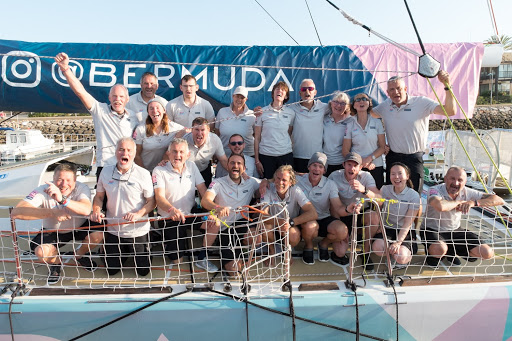
GoToBermuda team in Portimao ahead of Race 2
You are on the waiting list for Leg 8. If you come back, what personal learnings from your Clipper Race experience will you bring back?
I put my name on the waiting list for Leg 8 a few days before I left London, with the intention that I would love to be part of it. I started with Leg 1 and helped open the race, then to be on Leg 8 to be able to close that loop would be great.
I think I will have a better mindset of the race. I’d not just be able to use it as a window to check on my own development in that time, but also of that of the crew and the team as a whole, because, although I’m an engineer and a technical person by degree, I find people more interesting than machines.
I signed up to the race as I wanted to find a unique environment to test all the things I’d learned in the corporate world about teamwork, leadership, high performing teams, competency, development and dynamic risk assessment. Whoever is in the crew throws up different learning points. I couldn’t have found a better place to test some of my own thinking and theories in these areas. And if I were to go on Leg 8 with the crew members who envisioned being round-the-worlders that would be great as I think you would see a difference in them. You may be able to chart the progress and development they’ve made. It’s a unique pathway to see how they’ve changed.
Sailing wise, if I’m part of Leg 8, then I would for sure return with a much better technical sailing ability. There used to be little things before that used to throw me, like the foreguy but I used to ask to take responsibility in that area and master it. So hopefully, I’d be more well rounded as a crew member.
If you were taking a step back and analysing yourself, what would you say about how you’d changed your own mindset, from leaving London to arriving in Punta del Este?
For me the race has reinforced self-awareness, of things I felt I could be good at in a team environment and seen areas where I’m not as strong. It certainly underlined to me that I have a level of commitment and an ability to endure and not give up. To stay focussed and hopefully be a positive influence to those around, but that’s very much for others to say. I also recognised that there are areas where others are stronger than me and I’m comfortable with that. I’ve left the race feeling completely at ease and happy with my contribution.
I think I pushed myself as much as I could. If there was anything that was a learning point, I didn’t hide from that. I was more than happy to try it again.
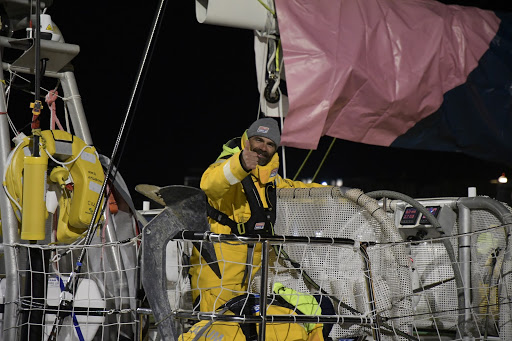
Arriving into Punta del Este after a tough Atlantic crossing
Which lessons from sailing can be brought into your personal and professional worlds? Have you started implementing any of them already?
Signing up to the race at the stage of my life and career that I chose was so I could take my experience and use it within a work context.
At the moment I’m advising companies how to improve their operational performance and to drive a people centric team culture. There’s no question that I’m drawing on things I've picked up on, on the race. Different styles and approaches and that underlying principle of being committed and absolutely determined and focussed to get results and do the best you can without alienating people
What would you say to someone who thinks that due to no sailing experience, the Clipper Race isn’t for them?
Very simply, you can do it. You just need to fully commit. Yes, there are hurdles to go through like the training but it’s important to make it your race. Set your own goals and don’t limit yourself.
Master the theory and the technical aspects but also be there to help your team.
Your life has taken you to places that suggested you should try sailing. Now that you are a sailor, what do you love about it the most?
What I loved most was that feeling of achievement. Setting out, charting a course and just getting there, despite what seems like an impossible distance to cover.
I love the open connection to nature. I thought that was wonderful, to be out at sea, even in the tough conditions that faced us, there were times where I just loved being there.
It’s funny you say, ‘as a sailor’. I was talking to a friend recently who has done his RYA Day Skipper and I said you are more qualified than me, and they replied, no, you sailed 7,500 nautical miles, you’ve crossed the Atlantic. I don’t walk around thinking I’m a sailor.
I now feel absolutely comfortable sailing and being on a boat. I had complete confidence in the equipment, the boat itself, the crew I was with. I also enjoyed the things that were new to me, like when the boat starts to heel over and you are at an angle, and things are thrown around, grabbing on and staying on, that physical nature of sailing.
But it still comes down to the human connection. I just loved the team achievement.

GoToBermuda celebrate arriving in Punta del Este after completing Leg 1
Quick Fire Q&A
What is the Clipper Race? Phenomenal
Describe yourself before the race: Excited
Describe yourself now: Stronger (both physically and mentally)
What is it like to be sailing into a storm: Exhilarating and adrenaline fuelled
What does GoToBermuda mean to you? A strong bond
Join The Race